2007 CHEVROLET MALIBU MAXX parking brake
[x] Cancel search: parking brakePage 93 of 510
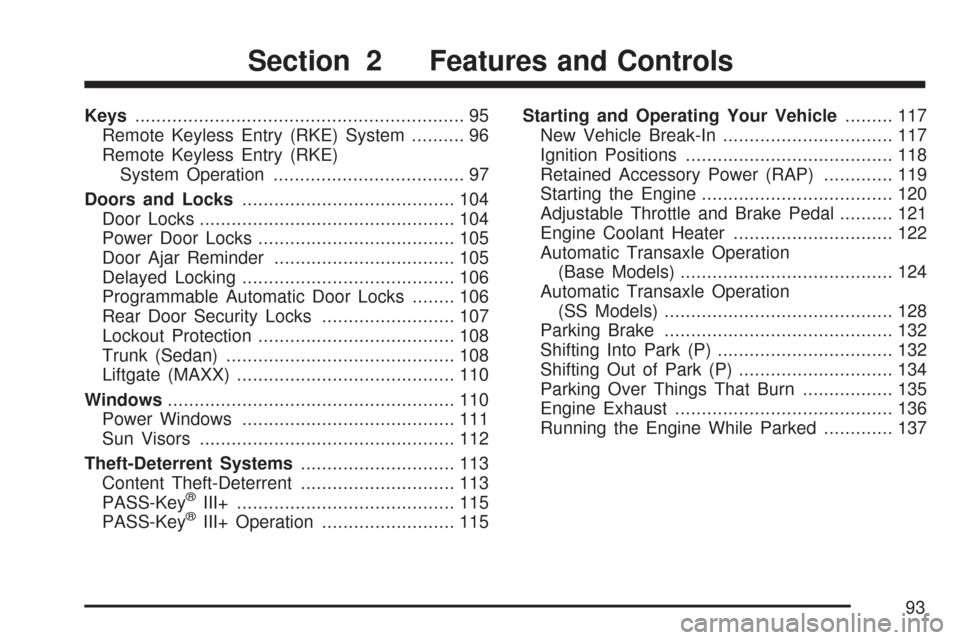
Keys.............................................................. 95
Remote Keyless Entry (RKE) System.......... 96
Remote Keyless Entry (RKE)
System Operation.................................... 97
Doors and Locks........................................ 104
Door Locks................................................ 104
Power Door Locks..................................... 105
Door Ajar Reminder.................................. 105
Delayed Locking........................................ 106
Programmable Automatic Door Locks........ 106
Rear Door Security Locks......................... 107
Lockout Protection..................................... 108
Trunk (Sedan)........................................... 108
Liftgate (MAXX)......................................... 110
Windows...................................................... 110
Power Windows........................................ 111
Sun Visors................................................ 112
Theft-Deterrent Systems............................. 113
Content Theft-Deterrent............................. 113
PASS-Key
®III+......................................... 115
PASS-Key®III+ Operation......................... 115Starting and Operating Your Vehicle......... 117
New Vehicle Break-In................................ 117
Ignition Positions....................................... 118
Retained Accessory Power (RAP)............. 119
Starting the Engine.................................... 120
Adjustable Throttle and Brake Pedal.......... 121
Engine Coolant Heater.............................. 122
Automatic Transaxle Operation
(Base Models)........................................ 124
Automatic Transaxle Operation
(SS Models)........................................... 128
Parking Brake........................................... 132
Shifting Into Park (P)................................. 132
Shifting Out of Park (P)............................. 134
Parking Over Things That Burn................. 135
Engine Exhaust......................................... 136
Running the Engine While Parked............. 137
Section 2 Features and Controls
93
Page 124 of 510
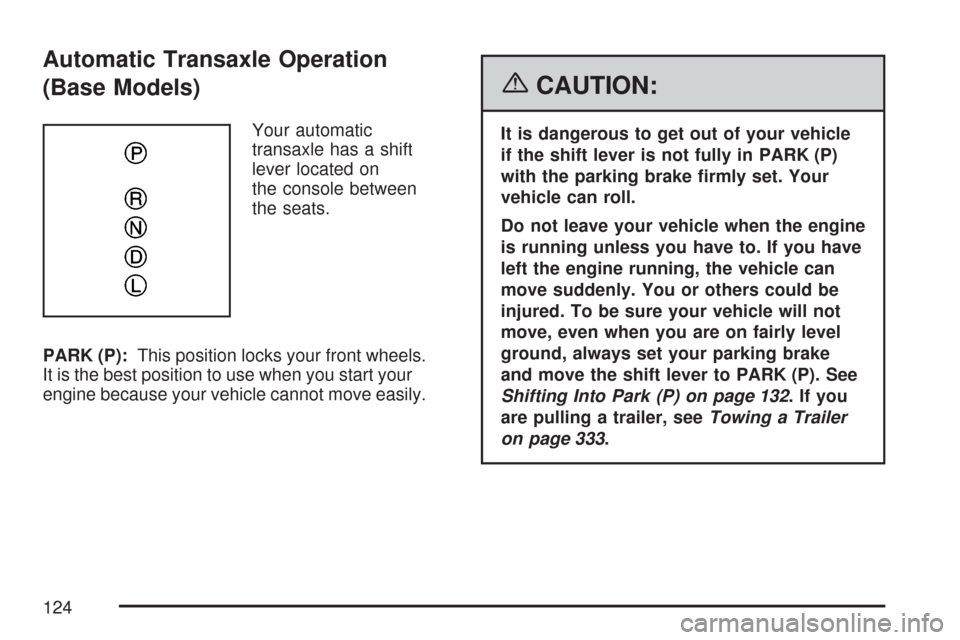
Automatic Transaxle Operation
(Base Models)
Your automatic
transaxle has a shift
lever located on
the console between
the seats.
PARK (P):This position locks your front wheels.
It is the best position to use when you start your
engine because your vehicle cannot move easily.
{CAUTION:
It is dangerous to get out of your vehicle
if the shift lever is not fully in PARK (P)
with the parking brake �rmly set. Your
vehicle can roll.
Do not leave your vehicle when the engine
is running unless you have to. If you have
left the engine running, the vehicle can
move suddenly. You or others could be
injured. To be sure your vehicle will not
move, even when you are on fairly level
ground, always set your parking brake
and move the shift lever to PARK (P). See
Shifting Into Park (P) on page 132.Ifyou
are pulling a trailer, seeTowing a Trailer
on page 333.
124
Page 128 of 510
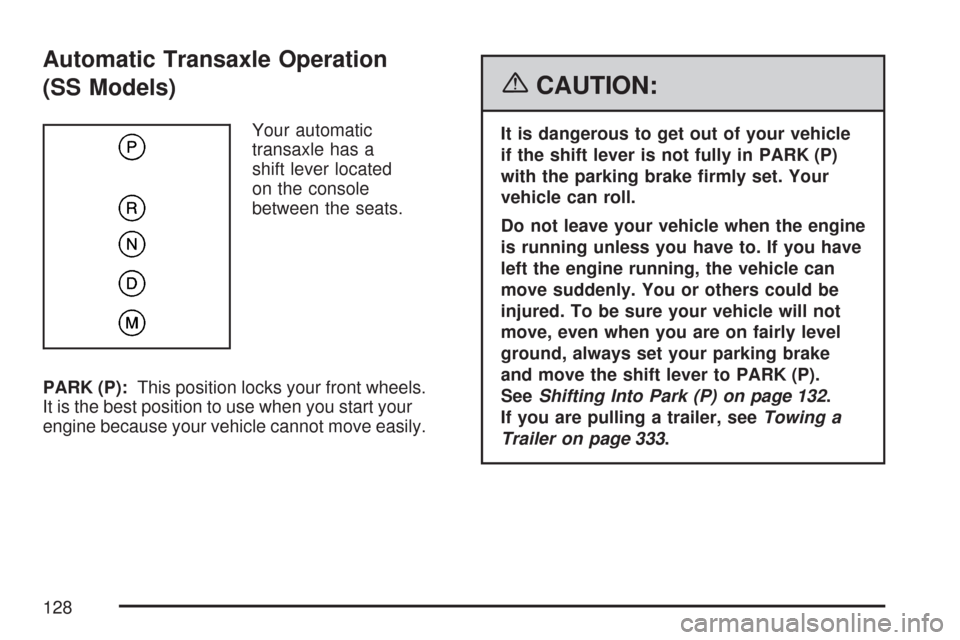
Automatic Transaxle Operation
(SS Models)
Your automatic
transaxle has a
shift lever located
on the console
between the seats.
PARK (P):This position locks your front wheels.
It is the best position to use when you start your
engine because your vehicle cannot move easily.
{CAUTION:
It is dangerous to get out of your vehicle
if the shift lever is not fully in PARK (P)
with the parking brake �rmly set. Your
vehicle can roll.
Do not leave your vehicle when the engine
is running unless you have to. If you have
left the engine running, the vehicle can
move suddenly. You or others could be
injured. To be sure your vehicle will not
move, even when you are on fairly level
ground, always set your parking brake
and move the shift lever to PARK (P).
SeeShifting Into Park (P) on page 132.
If you are pulling a trailer, seeTowing a
Trailer on page 333.
128
Page 132 of 510
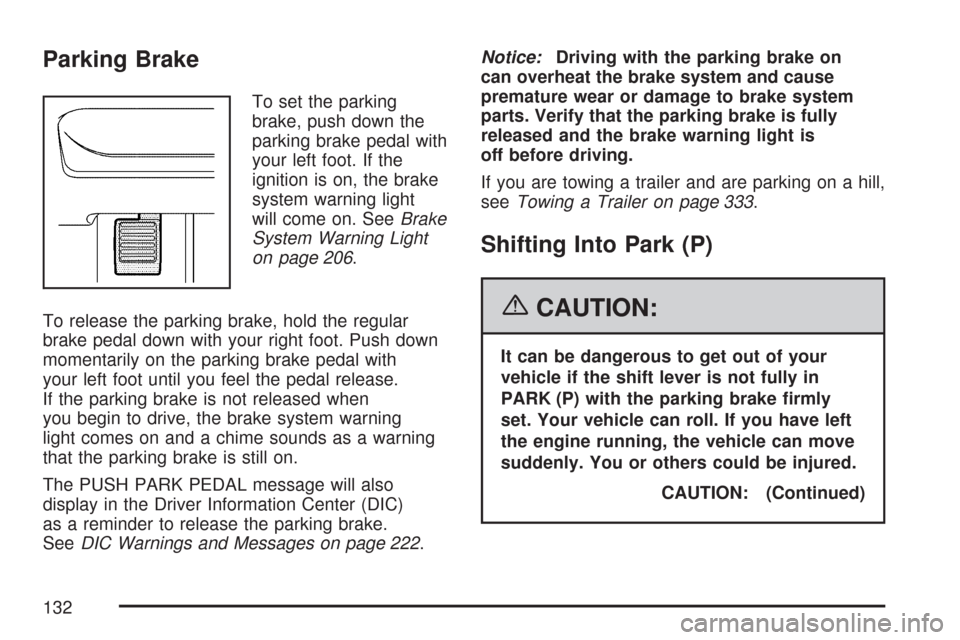
Parking Brake
To set the parking
brake, push down the
parking brake pedal with
your left foot. If the
ignition is on, the brake
system warning light
will come on. SeeBrake
System Warning Light
on page 206.
To release the parking brake, hold the regular
brake pedal down with your right foot. Push down
momentarily on the parking brake pedal with
your left foot until you feel the pedal release.
If the parking brake is not released when
you begin to drive, the brake system warning
light comes on and a chime sounds as a warning
that the parking brake is still on.
The PUSH PARK PEDAL message will also
display in the Driver Information Center (DIC)
as a reminder to release the parking brake.
SeeDIC Warnings and Messages on page 222.Notice:Driving with the parking brake on
can overheat the brake system and cause
premature wear or damage to brake system
parts. Verify that the parking brake is fully
released and the brake warning light is
off before driving.
If you are towing a trailer and are parking on a hill,
seeTowing a Trailer on page 333.
Shifting Into Park (P)
{CAUTION:
It can be dangerous to get out of your
vehicle if the shift lever is not fully in
PARK (P) with the parking brake �rmly
set. Your vehicle can roll. If you have left
the engine running, the vehicle can move
suddenly. You or others could be injured.
CAUTION: (Continued)
132
Page 133 of 510

CAUTION: (Continued)
To be sure your vehicle will not move,
even when you are on fairly level ground,
use the steps that follow. If you are
pulling a trailer, seeTowing a Trailer
on page 333.
1. Hold the brake pedal down with your right foot
and set the parking brake.
2. Move the shift lever into PARK (P) by pressing
the button on the shift lever while pushing the
shift lever all the way toward the front of
the vehicle.
3. Turn the ignition key to OFF.
4. Remove the key and take it with you. If you
can leave your vehicle with the ignition key in
your hand, your vehicle is in PARK (P).
Leaving Your Vehicle With the
Engine Running
{CAUTION:
It can be dangerous to leave your vehicle
with the engine running. Your vehicle
could move suddenly if the shift lever is
not fully in PARK (P) with the parking
brake �rmly set. And, if you leave the
vehicle with the engine running, it could
overheat and even catch �re. You or
others could be injured. Do not leave
your vehicle with the engine running.
If you have to leave your vehicle with the engine
running, be sure your vehicle is in PARK (P)
and the parking brake is �rmly set before leaving
it. After moving the shift lever into PARK (P),
hold the regular brake pedal down. Then, see if
you can move the shift lever away from PARK (P)
without �rst pushing the shift lever button.
If you can, it means that the shift lever was not
fully locked in PARK (P).
133
Page 134 of 510
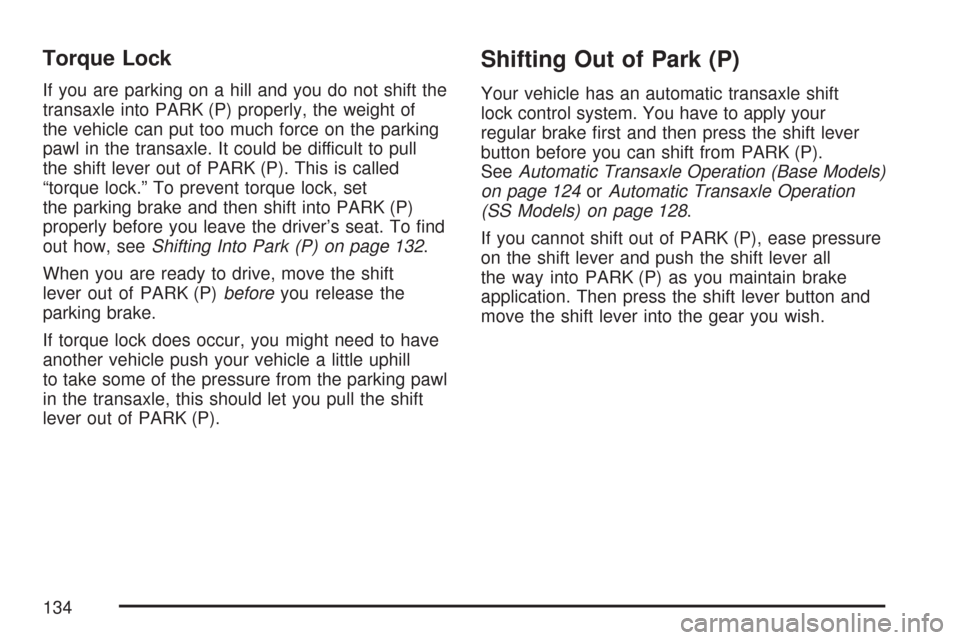
Torque Lock
If you are parking on a hill and you do not shift the
transaxle into PARK (P) properly, the weight of
the vehicle can put too much force on the parking
pawl in the transaxle. It could be difficult to pull
the shift lever out of PARK (P). This is called
“torque lock.” To prevent torque lock, set
the parking brake and then shift into PARK (P)
properly before you leave the driver’s seat. To �nd
out how, seeShifting Into Park (P) on page 132.
When you are ready to drive, move the shift
lever out of PARK (P)beforeyou release the
parking brake.
If torque lock does occur, you might need to have
another vehicle push your vehicle a little uphill
to take some of the pressure from the parking pawl
in the transaxle, this should let you pull the shift
lever out of PARK (P).
Shifting Out of Park (P)
Your vehicle has an automatic transaxle shift
lock control system. You have to apply your
regular brake �rst and then press the shift lever
button before you can shift from PARK (P).
SeeAutomatic Transaxle Operation (Base Models)
on page 124orAutomatic Transaxle Operation
(SS Models) on page 128.
If you cannot shift out of PARK (P), ease pressure
on the shift lever and push the shift lever all
the way into PARK (P) as you maintain brake
application. Then press the shift lever button and
move the shift lever into the gear you wish.
134
Page 137 of 510

Running the Engine While Parked
It is better not to park with the engine running. But
if you ever have to, here are some things to know.
{CAUTION:
Idling the engine with the climate control
system off could allow dangerous exhaust
into your vehicle. See the earlier caution
underEngine Exhaust on page 136.
Also, idling in a closed-in place can let
deadly carbon monoxide (CO) into your
vehicle even if the climate control fan is
at the highest setting. One place this
can happen is a garage. Exhaust — with
CO — can come in easily. NEVER park
in a garage with the engine running.
Another closed-in place can be a blizzard.
SeeWinter Driving on page 317.
{CAUTION:
It can be dangerous to get out of your
vehicle if the shift lever is not fully in
PARK (P) with the parking brake �rmly
set. Your vehicle can roll. Do not leave
your vehicle when the engine is running
unless you have to. If you have left the
engine running, the vehicle can move
suddenly. You or others could be injured.
To be sure your vehicle will not move,
even when you are on fairly level ground,
always set the parking brake and move
the shift lever to PARK (P).
Follow the proper steps to be sure your vehicle
will not move. SeeShifting Into Park (P) on
page 132.
If you are parking on a hill and if you are pulling
a trailer, also seeTowing a Trailer on page 333.
137
Page 169 of 510
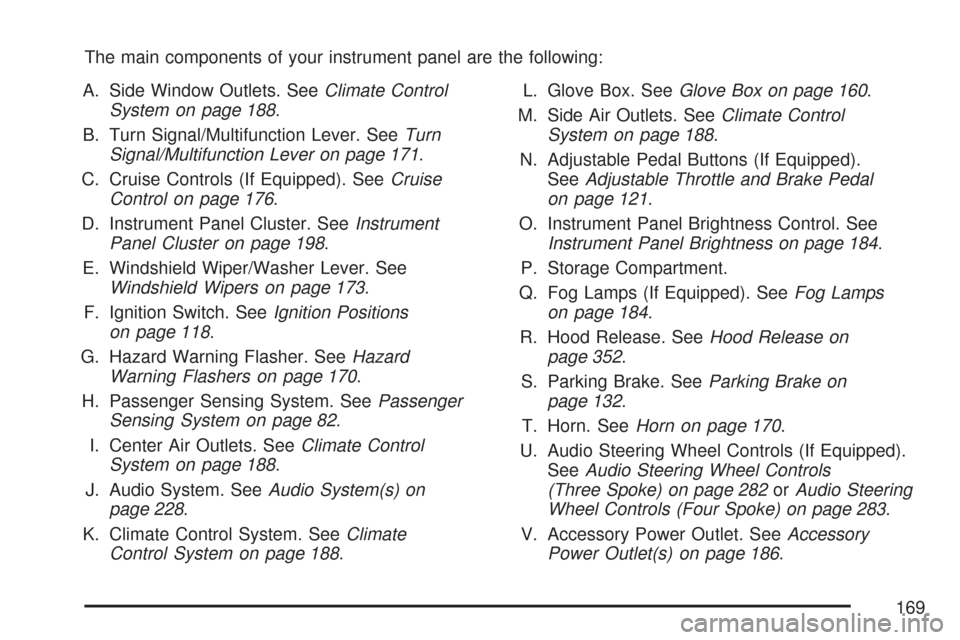
The main components of your instrument panel are the following:
A. Side Window Outlets. SeeClimate Control
System on page 188.
B. Turn Signal/Multifunction Lever. SeeTurn
Signal/Multifunction Lever on page 171.
C. Cruise Controls (If Equipped). SeeCruise
Control on page 176.
D. Instrument Panel Cluster. SeeInstrument
Panel Cluster on page 198.
E. Windshield Wiper/Washer Lever. See
Windshield Wipers on page 173.
F. Ignition Switch. SeeIgnition Positions
on page 118.
G. Hazard Warning Flasher. SeeHazard
Warning Flashers on page 170.
H. Passenger Sensing System. SeePassenger
Sensing System on page 82.
I. Center Air Outlets. SeeClimate Control
System on page 188.
J. Audio System. SeeAudio System(s) on
page 228.
K. Climate Control System. SeeClimate
Control System on page 188.L. Glove Box. SeeGlove Box on page 160.
M. Side Air Outlets. SeeClimate Control
System on page 188.
N. Adjustable Pedal Buttons (If Equipped).
SeeAdjustable Throttle and Brake Pedal
on page 121.
O. Instrument Panel Brightness Control. See
Instrument Panel Brightness on page 184.
P. Storage Compartment.
Q. Fog Lamps (If Equipped). SeeFog Lamps
on page 184.
R. Hood Release. SeeHood Release on
page 352.
S. Parking Brake. SeeParking Brake on
page 132.
T. Horn. SeeHorn on page 170.
U. Audio Steering Wheel Controls (If Equipped).
SeeAudio Steering Wheel Controls
(Three Spoke) on page 282orAudio Steering
Wheel Controls (Four Spoke) on page 283.
V. Accessory Power Outlet. SeeAccessory
Power Outlet(s) on page 186.
169